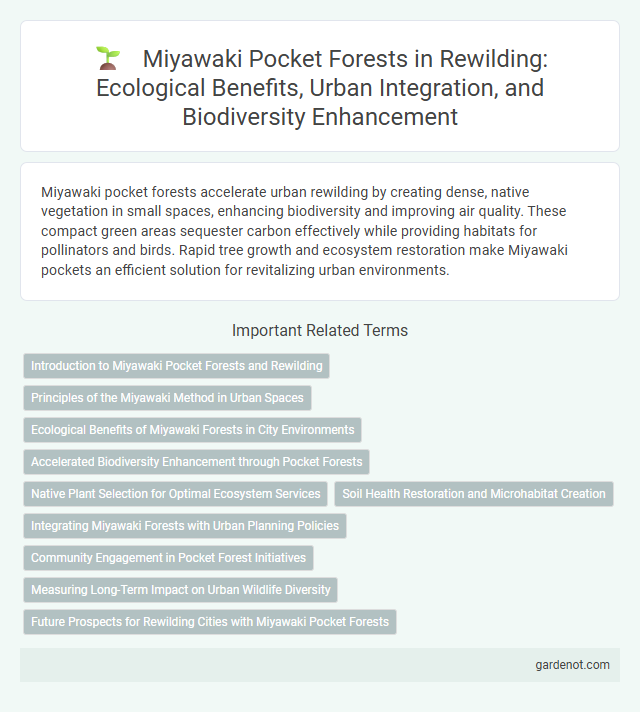Miyawaki pocket forests accelerate urban rewilding by creating dense, native vegetation in small spaces, enhancing biodiversity and improving air quality. These compact green areas sequester carbon effectively while providing habitats for pollinators and birds. Rapid tree growth and ecosystem restoration make Miyawaki pockets an efficient solution for revitalizing urban environments.
Introduction to Miyawaki Pocket Forests and Rewilding
Miyawaki pocket forests are dense, native tree plantations designed to restore natural ecosystems rapidly in urban areas, promoting biodiversity and ecological balance. These forests accelerate rewilding by creating microhabitats that support native species and improve air quality, soil health, and carbon sequestration. Integrating Miyawaki pocket forests into cityscapes enhances urban resilience and reconnects fragmented habitats, fostering sustainable environments.
Principles of the Miyawaki Method in Urban Spaces
The Miyawaki Method fosters rapid, dense forest growth in urban spaces by planting native species closely together, promoting biodiversity and ecological resilience. This technique emphasizes layering vegetation across multiple strata, from shrubbery to canopy, to mimic natural forests and enhance ecosystem functions. By restoring native habitats in compact areas, the Miyawaki Method contributes to climate mitigation, air purification, and urban heat island reduction.
Ecological Benefits of Miyawaki Forests in City Environments
Miyawaki forests enhance urban biodiversity by creating dense, native vegetation habitats that support a wide range of flora and fauna, promoting ecological balance. These pocket forests improve air quality through efficient carbon sequestration and particulate matter filtration, mitigating pollution in city environments. Furthermore, Miyawaki vegetation contributes to urban microclimate regulation by reducing temperatures and increasing humidity, which helps counteract the urban heat island effect.
Accelerated Biodiversity Enhancement through Pocket Forests
Miyawaki pocket forests enable accelerated biodiversity enhancement by rapidly establishing dense native vegetation in small urban areas, creating microhabitats that support diverse species. This method leverages native plant species grown closely together to simulate natural forest ecosystems, boosting flora and fauna variety within just a few years. These compact forests act as biodiversity hotspots, improving ecosystem resilience and offering vital green refuges in heavily urbanized environments.
Native Plant Selection for Optimal Ecosystem Services
Miyawaki pocket forests emphasize native plant selection to enhance biodiversity and restore ecosystem services effectively. Choosing region-specific species ensures optimal soil stabilization, carbon sequestration, and habitat creation for local wildlife. Native plants adapt better to local climate conditions, promoting faster growth and resilience in rewilding projects.
Soil Health Restoration and Microhabitat Creation
Miyawaki pocket forests enhance soil health restoration by accelerating organic matter accumulation, promoting microbial diversity, and improving soil structure through dense native plant growth. These compact ecosystems foster microhabitat creation by providing shelter, food sources, and breeding grounds for diverse insects, birds, and small mammals. The synergistic interaction between soil enrichment and habitat complexity supports resilient biodiversity and ecosystem services in urban environments.
Integrating Miyawaki Forests with Urban Planning Policies
Miyawaki pocket forests serve as a strategic tool in urban planning policies aimed at enhancing biodiversity and mitigating climate change impacts in cities. Integrating these dense, native-species forests into urban landscapes promotes ecological balance, improves air quality, and supports local wildlife habitats. Urban planners prioritize these forest pockets to create resilient green infrastructure that aligns with sustainable development goals and community well-being.
Community Engagement in Pocket Forest Initiatives
Miyawaki pocket forest initiatives drive community engagement by empowering local residents to participate in planting native trees, fostering environmental stewardship and enhancing biodiversity. Active involvement in these small-scale forests cultivates a sense of ownership, encourages environmental education, and strengthens social cohesion among urban communities. The collective effort not only accelerates rewilding but also creates resilient green spaces that improve air quality and urban microclimates.
Measuring Long-Term Impact on Urban Wildlife Diversity
Miyawaki pocket forests serve as vital urban biodiversity hotspots, with long-term impact measured through regular monitoring of species richness and abundance using standardized ecological surveys. Data collection on avian, insect, and plant species over multiple years reveals increased habitat complexity and ecological resilience within these rewilded urban patches. Advanced methods such as bioacoustic monitoring and remote sensing contribute to a comprehensive assessment of the Miyawaki method's effectiveness in enhancing wildlife diversity over time.
Future Prospects for Rewilding Cities with Miyawaki Pocket Forests
Miyawaki pocket forests offer a transformative approach to rewilding urban landscapes by rapidly creating dense, native forests in small city spaces, enhancing biodiversity and ecosystem services. These mini-forests contribute to climate resilience by improving air quality, mitigating urban heat islands, and supporting pollinators within metropolitan environments. Expansion of Miyawaki pocket forests in cities worldwide promises scalable green infrastructure that fosters ecological restoration and community well-being.
Miyawaki pocket Infographic

 gardenot.com
gardenot.com